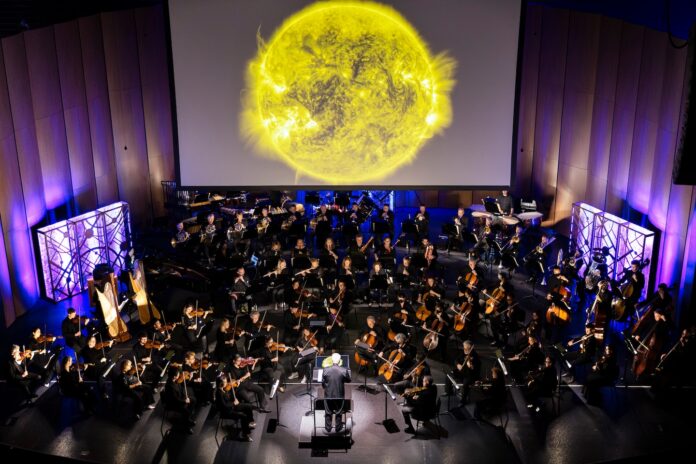In the past, the National Philharmonic has teamed up with NASA to create multimedia presentations of existing classical pieces, such as Gustav Holst’s “The Planets,” and such pairings of classical music and celestial imagery have become commonplace at any given planetarium. (The National Symphony Orchestra, for instance, will present its own program of “The Planets” coupled with NASA imagery on July 7 at Wolf Trap.)
With “Cosmic Cycles,” Dehlinger and a team of multimedia producers at NASA’s Goddard Space Flight Center flipped this process. The music was produced over the past year in an exchange of original music and images processed from the Hubble and James Webb space telescopes, as well as hundreds of richly rendered 3D visualizations, animations and simulations.
A grand seven-movement narrative arc emerges from the sequence of images and music, as the presentation shuttles listeners from the furnace of the sun to the cradle of the Earth, across the expanse of our still-mysterious solar system and onward into the squiggly lines and black holes of the unknown.
In a phone chat a week or so before Thursday’s premiere, Dehlinger said he could apprehend the vastness of space only by submitting a more meditative approach to the material (or lack thereof). But the results weren’t nearly as atmospheric as that might suggest.
Throughout the work, Dehlinger effectively builds atop the foundation of a searching four-note motif that echoes other monolithic melodies we’ve come to connect with the cosmos, including the clarion dawn of Strauss’s “Also sprach Zarathustra” or John Williams’s five-note hello from the film “Close Encounters of the Third Kind.”
But this theme becomes the basis for a harmonically rewarding wander through the stars that finds the substantial 81-piece orchestra — commandingly conducted by Piotr Gajewski — achieving unexpected lightness. (On a somewhat related note, Capital One Hall may have been a bit too appropriate a venue to virtually plunge us into the vacuum of space: Its acoustics are clear and close, but suffocatingly still. I expect there to be a bit more air in the air when the program repeats Saturday at Strathmore.)
Twinkling chimes and ascendant strings open the first movement, “The Sun,” which flies low over the churning surface of the closest star. A pipe organ traces the transit of the tiny black dot of Mercury across its boiling backdrop. Solar winds and bubbles of coronal plasma emerge as bursts of brass, with little flares of light registering as sweeps of harp.
The second and third earthbound movements dig more deeply into turfy textures: arpeggiating cellos assisting a data visualization in describing dust storms and volcanic eruptions; a whoosh of strings painting the sinister rainbow cloud of sulfur dioxide emissions; licking flutes enacting the flames of global wildfires seen from space. Elsewhere, the hiss of a rain stick underlines footage of atmospheric rivers, and a plodding glockenspiel trails animal migration patterns. An undulating meadow of strings runs below a map of global agriculture, a capture of the planet’s fertility and fragility.
Dehlinger’s music does wonders to freshen a sequence of sights we’ve never seen yet have seen a million times: photos from space of cities ablaze in electric light, mountain ranges rumpled like blankets, the branching veins of vast river systems.
In turn, the images seem to have drawn out an ambitious sonic palette. Much like space itself, stretches of “Cosmic Cycles” suffer from an impersonal uniformity. Dehlinger comfortably channels the tenderized awe of a well-produced nature documentary — a universal beauty that sometimes felt set to autopilot.
But he thrives when the cosmos gives him material to work with — like the pocked lunar surface of Schrödinger Basin, or the colossal wad of space granola targeted by the DART mission (Double Asteroid Redirection Test), or the colliding winds of a binary star.
At least some of this is pure instinct: Dehlinger told me he had followed an impulse when scoring the final movement of “Cosmic Cycles” in B flat. Later, when incorporating a NASA sonification of a particularly talkative black hole in the Perseus galaxy cluster, he realized that its horrifying howl was also in B flat — albeit 57 octaves below middle C.
It’s not easy to wick drama from data or sentiment from space, but Dehlinger’s orchestrations for potentially stale stills and inscrutable-but-pretty mathematics packed an unexpected emotional punch. Gajewski, along with his orchestra, was in fine form, handling the work’s many swerves and dives with ease and confidence. Kudos in particular to concertmaster Laura Colgate, whose several solos left gleaming trails in the air.
The evening closed with a short encore in the form of “Fanfare to Artemis,” penned by Dehlinger at the start of 2022, after the news of the Artemis mission to the moon but before he’d written a note of “Cosmic Cycles.” It was perhaps the most traditionally triumphant-sounding skyward salute of the evening — the Space Force could learn a thing or two. But with its big blasts of brass, it was also a reminder of what we want from the heavens in the first place: a sign that someone’s listening.
Cosmic Cycles repeats Saturday at Strathmore Music Center. nationalphilharmonic.org.



